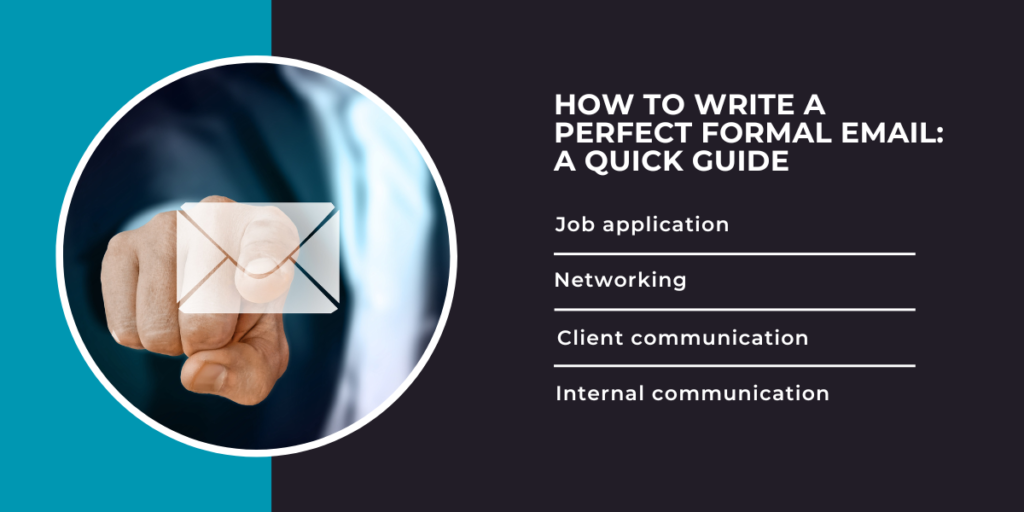Formal emails are a staple of professional communication. Whether you’re writing to a potential client, a colleague, or your boss, knowing how to craft a polished and professional email is essential.

Table of Contents
Factors of a Formal Email in Various Scenarios
Here is a comprehensive guide on how to write a perfect formal email, considering various major contexts:
Subject line – Formal Email
Your subject line is the first thing the recipient will see, so make it count. It should be clear, concise, and accurately reflect the content of your email. Avoid using all caps or excessive punctuation. Writing using the English language can be tricky at times.
Example:
- Job application: “Software Engineer Position at Google”
- Networking: “Introduction from [Mutual Connection]”
- Client communication: “Follow-up on [Project Name]”
- Internal communication: “Request for feedback on [Proposal]”
Greeting in a Formal Email
If you know the recipient’s name, use it. If not, you can use “Dear Sir/Madam” or “To whom it may concern.”
Example:
- Dear Mr. Smith,
- Dear Ms. Jones,
- Dear [Recipient Name],
- Dear Sir/Madam,
- To whom it may concern,
Introduction
State the purpose of your email in the first sentence or two. This will help the recipient understand what to expect and prioritize your email accordingly.
Examples:
- “I am writing to inquire about the Software Engineer position at Google.”
- “I am reaching out to you today because I was impressed by your recent presentation on [Topic].”
- “I am following up on our conversation about [Project Name] last week.”
- “I am requesting feedback on the proposal for [Project Name].”
Body
Keep your body paragraphs brief and to the point. Use clear and concise language, and avoid using jargon or technical terms. If you need to include a lot of information, consider using a numbered or bulleted list.
Example:
- “In my previous role at [Previous Company], I was responsible for developing and maintaining [List of Responsibilities].”
- “I am interested in learning more about your work on [Topic]. I am particularly interested in your research on [Specific Area of Research].”
- “I am pleased to provide you with the attached proposal for [Project Name]. I have outlined the project scope, timeline, and budget in detail.”
- “I would appreciate it if you could review the proposal and provide me with your feedback by [Date].”
Closing
Politely thank the recipient for their time and consideration. You can also use this section to reiterate your call to action or next steps.
Example:
- “Thank you for your time and consideration. I look forward to hearing from you soon.”
- “I hope to have the opportunity to connect with you in the near future.”
- “Please let me know if you have any questions or would like to discuss the proposal further.”
- “Thank you for your feedback. I will make the necessary changes and resubmit the proposal by [Date].”
Your Signature
Include your name, title, and contact information in your signature. You can also include a link to your website or LinkedIn profile.
Example:
- [Your Name]
- Content Writer
- [Your Company]
- [Your Email Address]
- [Your Website]
- [Your LinkedIn Profile]
Major contexts
Here are some additional tips for writing formal emails in various major contexts:
- Job application: Be sure to tailor your email to the specific position and company. Highlight your relevant skills and experience, and explain why you’re interested in the role. You can also attach your resume and cover letter to the email.
- Networking: When sending a networking email, introduce yourself and explain how you learned about the recipient. State your purpose for reaching out, and be clear about what you’re asking for. You can also mention something specific about the recipient or their company that you admire.
- Client communication: When communicating with clients, be professional and responsive. Be sure to address their questions and concerns promptly. You can also use email to provide clients with updates on projects, send them invoices, or schedule meetings.
- Internal communication: When communicating with colleagues, you can be a bit more informal. However, it’s still important to be respectful and avoid using slang or jargon. You can use email to share information, collaborate on projects, or request feedback.
Conclusion
By following these tips, you can write formal emails that are informative, professional, and effective.


Winston here from Iowa. I’m always watching for new sites and looking at older ones and thought I’d reach out to see if you could use a hand driving targeted traffic, automating repetitive tasks, or some good old fashioned bulk targeted outreach campaigns to lists I already own.
I’ve been doing this for over 20 years — building sites, editing videos, crafting bulk email campaigns (I even provide the targeted lists as I mentioned), running traffic, creating custom software, fixing and optimizing WordPress sites, I’ll even pay for any plugins you might want/need. If a solution exists, I’ve probably built it or bought it — and if I haven’t, I will for your project. I’m happy to shoulder 90% of the cost with tools, lists, licenses, and tech I already own.
All I ask is a flat $99/month for my time, month to month — no catch. I don’t mean to impose, I just wanted to offer real help if you’re open to it.
Quick background: born and raised in the Midwest, married, three girls. If I can support them by helping you using everything I’ve built over the years, that’s the kind of win-win I can imagine. It still amazes me how few people actually help the way I do — and I’d love the chance to show you.
If you need anything at all, just ask, doesn’t cost anything to do that.
P.S. – If I missed something you might need help with, just ask. I only scratched the surface here.
All the best,
Winston
Cell: 1-319-435-1790
Chat with me anytime: https://kutt.it/deserve